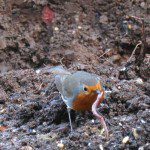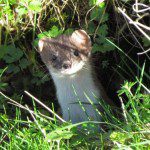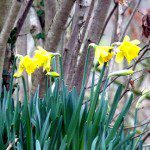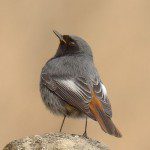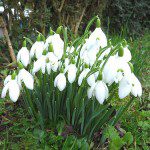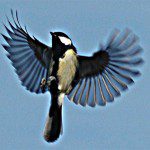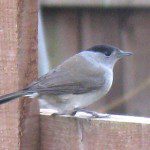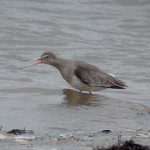Axe Estuary Birds No 150 February 15th 2011
NB: The following is reproduced by kind permission of Axe Estuary Birds. Full credit goes to the team that produces the newsletter (see the bottom of the post for specific details). Photographs are credited throughout the text although we are working to preserve the original layout wherever possible in the future.
The Birds
On the whole it has been a fairly quiet week. As I write this 150th edition of Axe Estuary News, it is St.Valentine’s Day, the first day of National Nest Box Week, the day traditionally that birds think about choosing a mate. Certainly in our garden some seem to have jumped the gun – Robins are pairing up, Dunnocks singing and of course the Pigeons, who have been at it all year! Unusually we have had a pair of Reed Buntings in our garden at Colyford; I think that is the first time in 11 years.
Karen Woolley saw a pair of Great Bustards in Dorset – wonderful for her, but not on our patch. Closer to home she saw this Black-tailed Godwit, apparently yawning, and this lovely Black Redstart which she thinks is her best photograph of it yet.
Simon Wakely got this stunning photograph of a Great Tit in his garden, and another of a Robin doing battle with a huge earth worm. I suspect the Robin won!
Colyford Common.
Interestingly two pairs of Mute Swans were noted on the reserve on the 6th; ALF and ALU continued to graze close to the boardwalk but a new pair seem to have taken over their breeding ‘patch’ in the southern corner of the reserve used by them last year. Typically, c20 Mute Swans are to be seen on the fields below Stedcombe and the Bewick’s was again with them on 1st and 6th as was the Greylag Goose on the 6th; the flock of Canada Geese frequenting the marsh and the fields below Stedcombe remained at 32-33. About 900 Wigeon were noted on the 1st and 95 Teal were flushed from the scrape area by a passing Sparrowhawk. These diminutive ducks are notoriously difficult to count as they ‘hide’ in the narrow channels and behind grass tussocks of the marsh. A single Shoveler was seen on the scrape on 1st and a single Peregrine was noted over the marsh on 3rd. Lapwing flocks are quite mobile within the valley but c900 were present on the marsh late afternoon on the 6th. Some remarkable counts of gulls were made on the marsh on 5th when 1250 Black-headed, 85 Common, 35 Herring, 14 Lesser Black-backed and 4 Great Black-backed Gulls were present. 10 Rock Pipits, possibly of the Scandinavian ‘littoralis’ type were on the reserve on 1st. Corvids seem to be forming quite mixed flocks, about 200 strong, at times on the reserve and marsh with a count of 40 Jackdaws, 80 Rooks and 100 Carrion Crows on the 1st (when a Raven flew over the reserve), being typical.
A Stoat was seen running along the boardwalk parallel to the ditch near the hide on 1st. Photo Sue Smith.
Ian McLean’s seawatching produced Velvet and Common Scoter, Red-throated Diver, Razor Bill and 230 Gannet.
There are several Blogs of interest – well worth looking at once a week or so, for both local bird news and wonderful photographs:
http://karenwoolley.blogspot.com/
http://stevesbirdingblog.blogspot.com/
http://notquitescilly.blogspot.com/
http://www.timwhitewildlife.blogspot.com/
http://devonbirdnews.blogspot.com/
You might also like to look at this website, which details a walk at the end of May that celebrates the Tree of Life http://ancestorstrail.net/.
Ringing
A tremendous turnout this morning (12th ) with 25 volunteers, but only 27 birds comprising of 26 (18) Shelduck and one Crow! Only a few Shelduck were bearing colour-rings from previous catches so although only a few birds it was a useful catch for colour-ringing. Many thanks to you all for coming along especially those of you who travelled from so far.
The next session is a public demonstration, part of the Wet and Wild Weekend, on Saturday 26th February at which Mike Hounsome has agreed to be ringer-in-charge as per our new programme. This will be at the new Field Centre at Black Hole Marsh, approached from Colyford Common.
News from Holyford Woods
Spring is advancing rapidly now. On the first of February there were 3 blobs of frogspawn in the pool, the first bluebells had broken through the leaf litter, celandines and primroses were showing in lots of places, red campion shoots were up and foxglove plants growing. The catkins are at their golden best now. Now there are 30 blobs of frogspawn, the bluebells are up everywhere, and all the other ground cover plants are growing rapidly. The birds are more vocal and today I have seen and heard a Song Thrush, and a Mistle Thrush, the 3 Buzzards cruising over Seaton Down, and the Raven in its usual tree. Over the last two weeks I have twice heard a Tawny Owl calling in the day. A big thank you is due to members of the AVDCS together with some locals who have made a wonderful job of clearing the undergrowth and willows from the bank on the North side of Top Pool. It was always smothered with primroses, so we hope they will come through for this year. Together with some clearing of the glade through the conifers, there is now a view right across to the top of The Hangings. Jean Kreiseler.
The Trivia
Signs of spring are everywhere, from Snowdrops to Catkins, Daffodils. and Snowdrops by Peter Vernon.
Blackcap by Stuart Olliver, of Elizabeth Road, Seaton, taken through his kitchen window. It’s been around since December, and his father, Bob, has had a female Brambling in his Colyton garden.
Garden Bird Watch
No doubt many of you took part in the RSPB Big Garden Birdwatch again this year, and you may remember that we have done something similar, on a much smaller scale, for the last few years. And we plan to do it again this year over the weekend of 5th and 6th March. There is a suitable form attached to this email. It doesn’t matter how far away from the Axe Valley you are – entries from Colyford or California, Botswana or Brisbane all equally welcome. There was not a huge response last year – lets hope for more this year.
Wet and Wild Weekend 26th and 27th February and Birds for Beginners
Numerous events on both the Saturday and Sunday, including Bird Ringing, Guided Walks, Tram Trips etc. If you feel like helping, you would be welcome. All the Wet and Wild guided events start at the Field Studies Base and all the tram trips start at Seaton Terminus.
Birds for Beginners this Friday 18 Feb with a morning session (10am – 12 noon) in one of the hides on the northern end of the Wetlands (so either Colyford Common or Island Hide). The ranger for the day will be Jim Hunter and he will decide which hide to use and will put a notice at the Colyford Common and BHM entrances. In the afternoon he will move down to Seaton Marshes for 12.30 until 2.30pm
For full details contact Diane Berry 01395 517557 or go to www.eastdevon.gov.uk/countryside.
This twice-monthly email newsletter is freely available to anyone who would like it, as is a periodic one about the activities of the East Devon Local Group of the Devon Wildlife Trust. Just send me an email with Axe Estuary Birds and/or East Devon DWT in the subject line. Also, for those without a computer, I will send a copy by post if you would like to send me some stamps.
Thanks to those who keep me informed. Please continue to tell me of any unusual, interesting or amusing sightings, and what is about locally, and send any photos you would like to share.
Mike, Jean, and David. (and many others!) davidwalters@eclipse.co.uk. tel. 01297 552616 Mobile 0779 1541 744.

